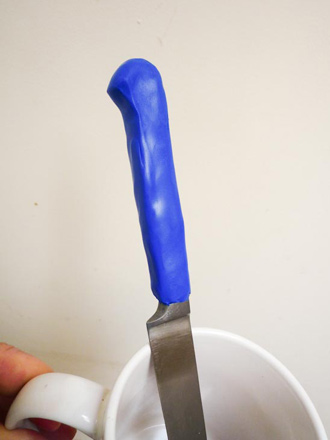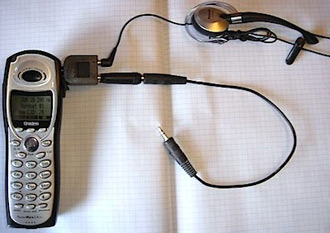Tuesday, December 07, 2010
The English Room-30 Days of Poetry-Student Activity
Monday, September 06, 2010
Saturday, September 04, 2010
Sugru
Sugru is a soft moldable material that reminds me of Fimo clay. But unlike Fimo, it does not have to be heated to cure. It air drys and is rubbery and sticks to anything. I used it to make a new button for my utility knife when the plastic one broke. I made bumpers for my cell phone. I put some on my tools so they would not roll off the table. I am still discovering ways to use the product.
-- Philip Lipton
This stuff comes in tiny pouches of different primary colors. You knead a bit with your hands until soft, then you apply it where you would like an additional grip, or stop, or section of repair. It's pretty sticky, can be worked like clay, but dries into a hard rubber. The photo shows a paring knife handle that was falling apart from years of dishwasher use. I coated the outside with Sugru and it now it feels great and is dishwasher proof. See Sugru's website for other ways it can be used.
-- KK
Hands-Free Phone-Interview Setup
It's a serious issue in contemporary journalism: how do you record phone interviews while using a headset?
Radio Shack sells a nice, cheap device (the previously reviewed Mini-Phone Recorder) that interrupts the cord that goes from the handset to the phone, which works well when you're using the handset. But when I do interviews by phone, I like to type a rough transcript while I talk, and typing while clamping a handset to your ear with your shoulder can quickly get painful.
When I first confronted this problem earlier this year, I spent a lot of time on the internet looking for solutions. The ones I found were pretty unappetizing. The main technology on offer is a microphone that you stick in your ear, which seems both unpleasant and ineffective.
But then I encountered the good people at Sagebrush.com, who invented this elegant and inexpensive solution, which uses about $20 worth of stuff you can get from Radio Shack.
You need three items:
1. the Gold Series Y-Adapter, 3/32" Stereo Jacks & 3/32" Plug, which is item # 2264801 and costs $7;
2. a 1/8" Stereo Jack to 3/32" Stereo Plug Adapter, which is item # 2160379 and costs $6; and
3. a 12-Inch Shielded Stereo Audio Cable, which is item # 2265306 and costs $6.
The Y-Adapter splits the signal coming out of your phone's headset jack. One line goes to the headset; the other goes to the recorder.
Arguably, this is more of a hack than a Cool Tool. But it works (as long as your phone has a headset jack). And it's very portable: you can also use it on the road by plugging into a cell phone.
Wednesday, September 01, 2010
Sunday, August 29, 2010
Tuesday, August 24, 2010
Charles Jennings: Why focus on informal and social learning - Internet Time Alliance
Charles Jennings: Why focus on informal and social learning - Internet Time Alliance - Annotated
"Forgotten before it's needed"--what an odd expression! Still rolling that idea around in my chinese checker tin.
How To Become A Culture Hacker (Ignite 2010)
Thursday, August 19, 2010
Thursday, August 12, 2010
Anthologize
I have been experimenting with it all morning and although it is in alpha I find it to be in general working order. Anthologize is a result of the One Week One Tool initiative sponsored by Center for History and New Media (CHNM) at George Mason University. The idea was "more hack and less yack". In other words CHNM proposed wanted "... a unique kind of institute: One Week, One Tool will teach participants how to build a digital tool for humanities scholarship by actually building a tool, from inception to launch, in a week—a digital humanities barn raising."
If you are interested here is some homework for you:
Read this overview of the tool and why it is so important.
Join this Zotero group if you want to keep apprised of links and resources.
Help out with work towards a beta version here.
Or check out a first rough attempt at using Anthology and exporting the output to Scribd as a pdf.
http://anthologize.org/
Tuesday, August 10, 2010
Be Safe, Be Ethical, Be Awesome

I just made “be safe, be ethical, be awesome” as my desktop background.
Sweet. I have been working to get schools to adopt at the very minimum
some sane social networking policies, but always in the background I am
wondering, “Is any of this really necessary?” Probably not in sane
systems. Isn’t the fact that we ‘need’ dress codes and AUP’s indicative
of a systemic illness or at least a failure of scale? Thanks for the
great image monika and thanks for sharing them.
Monday, August 09, 2010
"Next Practices” or "How Curiosity Actually Saves the Cat"


I love finding useful, thought-provoking and oddly congruent ideas from other disciplines. I have thoroughly enjoyed reading Wikibon lately and this post's graph is a good example. I have always railed against the notion of a generalized 'best practice' because it is so contrary to complex and diverse systems like classrooms. You may have your own best practice, but only if it is customized to you. But I do like the idea of 'next practice' . We should be wandering about inside and outside our disciplines foraging for not just the new new thang, but the idea or practice that is both practical and unique. In other words it must be both do-able as well as be appealingly fresh to our brains. If it is practical then we won't reject it out of hand and if it is unique, then it sets off all kinds of interesting and happy chemical cascades in our brains.
I use my social bookmarking tools, Diigo especially, to find these handy and 'deviant' tools. (Deviant in the statistical sense of standard deviance.) Here are a couple of qualifying samples of the unique and practical.
Productivity guru, Mark Forster, has developed a method for getting stuff done that he calls Autofocus . I am considering giving this tool a whirl, but the little piece of deviance I have found is in a reference to an animation created by Andreas Hoffman that demonstrates how the technique is done. When you click on the 'animation' you download a pdf. When I first opened it I thought Forster had the link wrong, but then you notice that the pdf has over 600 pages. Hoffman has used each pdf page like an animation cell. This is certainly a deviant use for pdf, but one that is unique and practical. Are there other uses for this 'animation style'? Could I combine this pdf with a screencast? Acrobat has an automatic scroll function so you could start your screencast and then autoscroll. I am sure others can come up with something sweeter and better with a little thought, but this a prime example of a deviant use that is completely handy.
Another example is the messaging/threading function I have just discovered in Diigo. Below is a screenshot from my account with annotations:

Like I wrote in my annotation, I don't use anything like this anywhere in my toolkit. I think it is very practical for the classroom in light of the very safe, secure, and social "Teacher Console" within Diigo for K-12. In higher ed it encourages social connection inside and out of the classroom as well as legitimizing right click research for students. This is the first tool I teach my students each semester and with this new messaging system, it, like the rug in "The Big Lebowski", really ties the 'room' together, dude.
Last, I am always looking for new presentation tools and styles for my students. I have adopted the pecha kucha for the last couple of years for its sheer fun and effectiveness. Students love it, too. Although this style doesn't lend itself to improvisation (which I am very attracted to in my own teaching) I have recently discovered a way to combine two familiar tools into one that could be instructive and fun in the classroom. It is called "Battledecks" and can best be described as powerpoint karaoke. Below is a rather profane video of Anil Dash putting battledecks through its paces.
Will I use this in my composition class this year? It is fondly to be hoped. Perhaps after we research a particular topic and write a paper I will put together a battledeck or two or ten based on that topic and see where my students take it. This means that I will have to practice battledecking myself. I find that tools owned are tools shared.
My larger point here is that we need to have our internal radar up as we free range for new stuff to integrate into our classrooms. All you need to do is to stick out those antennae that sense what piques you. It is a capacity we all have, but sometimes we don't allow it to come out and play. The affordances it offers are staggering. You never know what glorious fun will come from a spin of that wheel, but I guarantee it will be interesting especially if you offer your students the same opportunity.
Thursday, August 05, 2010
Get Outside Your Echo Chamber

Kevin Kelly -- KK* Lifestream
"In the network economy, nine times out of ten, your fiercest competitor will not come from your own field. In turbulent times, when little is locked in, it is imperative to search as wide as possible for places where innovations erupt. Innovations increasingly intersect from other domains. A ceaseless blanket search--wide, easy, and shallow--is the only way you can be sure you will not be surprised. Don't read trade magazines in your field; scan the magazines of other trades. Talk to anthropologists, poets, historians, artists, philosophers. Hire some 17-year-olds to work in your office. Make a habit to visit a web site at random. Tune in to talk radio. Take a class in scenario making. You'll have a much better chance at recognizing the emergence of something important if you treat these remote venues as neighbors."
Reading Kevin Kelly's admonition to cast a wider net into other disciplines comes from the simple observation that many innovations come from outside one's own field. Revolutions rarely come from within. In that spirit I would like to request that others write a little about the outside sources that jostle the status quo within education either intentionally or by accident.
Here are a few sites I recommend to get you out of your edublogging echo chamber:
1. One of my favorites is Kevin Kelly and Gary Wolf's The Quantified Self. Any look at recent posts will inspire you to think about your own discipline.
* For example, why can't classes be more like Meet-Ups? Some of my most successful classes were ones where we met socially for breakfast or coffee/tea. Why not have a Meet-Up Monday?
* What about observing our disciplines and student use of tools within the discipline? A recent post about Bill Jarrold describes how he uses the command line to log productivity. Why not use Twitter and Twitter hashtags to "log" writing productivity of all sorts that your students produce? I teach composition and have wondered about my students' writing lives. This would be a good way to open up a can of observation on 'em.
* What about foursquare to extend the boundaries of your classroom? I have been wondering about how to bring games into the classroom and this might be it. What are the affordances of foursquare in the classroom? This post suggests a data visualization for it and some more ideas. Yes, I think this will do.
2. Another one is ze frank's page:
* I love how the effectiveness of the blog-comment template is shown so well here. It is a pattern that any writer can use to attract an audience. Besides it demonstrates one of ze frank's principles so well--surprise is everywhere.
3. Or Dave Snowden's excellent and evocative Cognitive Edge. While technically inside of the envelope of learning and education he also writes about leadership and family.
* Snowden's software, SenseMaker Suite, might be applicable to my burgeoning dissertation interest in social capital in professional learning communities.
* Or perhaps you discover a quote that thoroughly bumfuzzles your mind like this one: "In general, if a community is not physically, temporally and spiritually rooted, then it is alienated from its environment and will focus on survival rather than creativity and collaboration." This may seem obvious to many, but to me it points to the sterility of classrooms in general and to mine in paricular. One of the oddest feelings I have gotten since I moved from teaching high school to university has been a 'coldness'. I miss the heat of high school and I think this quote explains this in part and points me toward a major goal for fall classes--figure out ways to root my classes. And I also think about how to 'root' my online classes as well.
4. How about Scott McCloud's Mind Dump where I discovered:
* Eric Mazur's physics class where he makes the awesomely sensible and arguable assertion that you can forget facts but you can't forget understanding. This guy is my new hero and I am determined to apply some of his techniques for physics to my lit and comp classes.
* Or perhaps I will be moved to print up this quote from Seth Godin that McCloud points to for our consideration: "The internet has dramatically widened the number of available substitutes. You don't have to like it, but it's true. That means you have to work far harder to create work that can't easily be replaced." How can I make myself less replaceable? That is an essential question for every world class employee who wants real job security.
How about the blog Sports Are 80% Mental ?
* File this under the category "Everything You Know Is Wrong": "Physical activity had no impact on weight change, but weight clearly led to less activity." In other words don't be hatin' on the fat man or boy or woman or girl. My second thought when I read this was whether there are similar 'Truths' in my discipline that need puncturing. What are the assumptions that guide my work that might be wrong? I will be on my guard for this during the upcoming school year and will report back.
The idea that innovation comes from the margins seems right biologically-- growth occurs along the edge (wherever that might be). So my challenge to you is to bring back similar (and better) missives from the fraxillated margins. Just fold one interest right on top of another and that's where you might want to be.
Tuesday, August 03, 2010
Podcasting for Kids
This is good information on how to do a podcast, how to integrate it into what teachers do, and how to justify it. I can see how valuable this might be as a solid first step toward a larger goal. And what would that large goal be? To show kids how to get inside their heads and find the stuff they are passionate about and then use the tool to convey that passion. At their age they need just enough skill to balloon their personal joys into the air.
Quel Difference!
-
McGee’s Musings : “The cure for boredom is curiosity. There is no cure for curiosity.” – Dorothy Parker - Annotated
- It's largely about the enormous difference between News and New to human minds. Marketing people really want News (= a little difference to perk up attention, but on something completely understandable and incremental). This allows News to be told in a minute or two, yet is interesting to humans. New means "invisible", not immediately comprehensible, etc.
-
Posted from Diigo. The rest of my favorite links are here.
Friday, July 30, 2010
Academic Productivity » The Future of the Journal, by Anita de Waard
-
Academic Productivity » The Future of the Journal, by Anita de Waard - Annotated
-
A somewhat related idea are the 5 stars of open linked data:
★ make your stuff available on the web (whatever format)
★★ make it available as structured data (e.g. excel instead of image scan of a table)
★★★ non-proprietary format (e.g. csv instead of excel)
★★★★ use URLs to identify things, so that people can point at your stuff
★★★★★ link your data to other people’s data to provide context
-
-
Posted from Diigo. The rest of my favorite links are here.
Wednesday, July 21, 2010
Principals Say: “I Don’t Know How To Do That” « Pedagogies of Abundance
Must read for anyone who wants to walk in the shoes of our principals.
Quotes:
Principals Say: “I Don’t Know How To Do That” « Pedagogies of Abundance
This message was sent to you by Terry Elliott via Diigo
Getting too many email alerts? Change your email alert setting preference here.
Principals Say: “I Don’t Know How To Do That” « Pedagogies of Abundance
Must read for anyone who wants to walk in the shoes of our principals.
Quotes:
Principals Say: “I Don’t Know How To Do That” « Pedagogies of Abundance
This message was sent to you by Terry Elliott via Diigo
Getting too many email alerts? Change your email alert setting preference here.




